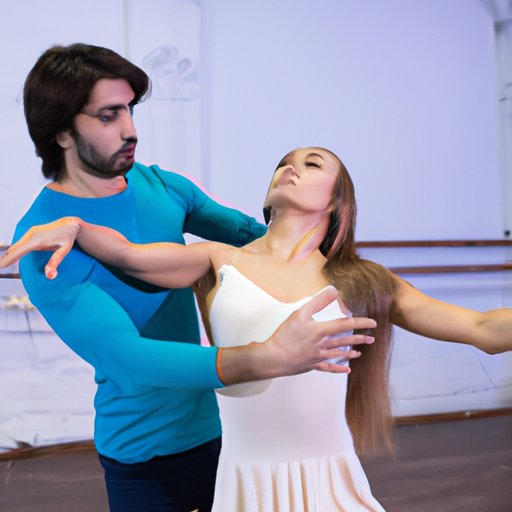
Introduction
Slow dancing can be an intimidating experience, especially for beginners. However, it’s a fantastic way to connect with your partner, reduce stress and physical activity. Even more, slow dancing is a romantic pursuit that creates intimacy between couples. The key to enjoying slow dancing lies in mastering the right techniques, reading body language, and non-verbal communication while being comfortable with yourself and your partner.
10 Easy Steps to Mastering Slow Dance: Expert Tips for Beginners
Slow dancing follows a basic rhythm of moving in time with the music, but it involves a lot more than that. To get comfortable with slow dancing, follow these ten easy steps:
- Find a partner and stand close to each other, making sure that your palms are touching.
- Place your left hand on your partner’s shoulder and hold your partner’s right hand with your right hand.
- Take a small step forward with your left foot, while your partner moves back with their right foot, starting the dance with a step to the left.
- Next, step back with your right foot, while your partner takes a step forward with their left foot, completing the first sequence of the dance.
- Repeat the first movement with the opposite foot and continue alternating between left and right feet movements according to the pace of the music.
- Make small swaying motions with your hips, while keeping your upper body stable.
- Ensure that you maintain an appropriate distance from your partner while respecting their comfort level.
- Keep eye contact with your partner, focusing on the level of connection between both of you.
- Practice often with your partner, experimenting with different moves and variations.
- Relax and enjoy the moment while dancing, noticing how the rhythm flows through your body.
Remember, the key to becoming a confident slow dancer is to focus on your movements, relax, and let the music guide you.
How to Lead and Follow in Slow Dancing
In slow dance, there’s a leader and a follower, and each partner plays a critical role in the dance. If you’re leading, your primary responsibility is to guide your partner through the dance. Meanwhile, if you’re following, your job is to respond to your partner’s movements.
To be a great leader or follower in slow dancing, you need to consider body language, be confident, and communicate non-verbally. As a leader, make sure your partner is comfortable and ensure a great time for both of you. Similarly, as a follower, structure your movements according to your partner’s and enjoy the moment.
The Dos and Don’ts of Slow Dancing
Slow dancing requires respecting your partner and providing an appropriate environment where both can enjoy the moment. Here are some essential dos and don’ts with great significance:
Do:
- Ask your partner politely before asking them to dance
- Dance within your comfort zone, and respect your partner’s comfort level
- Practice personal hygiene when dancing with someone
- Enjoy the moment without drama and interact with your partner
- Wait for the song to finish before saying goodbye to your partner
Don’t:
- Grabbing your partner’s body too tightly and applying force
- Give unwanted sexual advances during the dance
- Criticize your partner or argue during the dance
- Ignore your partner, or leave them alone while dancing
- Engage in any unwanted physical contact with your partner
The Top 5 Classic Slow Dance Songs
A great slow dance song can make the moment unforgettable. Here are some of the most popular and classic slow dance songs:
- “I Will Always Love You” by Whitney Houston
- “Unchained Melody” by The Righteous Brothers
- “At Last” by Etta James
- “When a Man Loves a Woman” by Percy Sledge
- “Can’t Help Falling in Love” by Elvis Presley
Each of these songs is perfect for any slow dance, and you don’t have to be an expert to enjoy them. The key is to let the music guide your movements and enjoy the moment.
Slow Dance for Couples: Connecting Through Movement
Slow dancing creates an intimate and emotional connection between couples. Slow dancing creates an opportunity to connect, both physically and emotionally, with your partner and enhances the feeling of love and emotion.
To make the moment more meaningful and intimate, light candles, set the mood with great music, and let the dance guide you. Look your partner in the eyes, emphasize hand placement and placement, and let yourselves enjoy the moment.
Slow Dance for Fitness and Wellness: Benefits and Tips
Slow dancing has numerous health benefits, and it’s an excellent way to stay active for people of all ages. Here are some of the health benefits slow dancing:
- Improved cardiovascular health
- Burns calories and helps with weight loss
- Reduces stress and anxiety
- Increases balance and coordination
- Enhances muscle strength and flexibility
Tips for making slow dance a fun and beneficial experience include:
- Take breaks and rest as often as possible
- Improve your breathing techniques to improve your endurance during dancing
- Wear comfortable shoes to allow unrestricted movement
- Consider taking up dance classes to improve your skill.
Conclusion
With these tips and techniques, you can go from a beginner to a slow dancing expert in no time. Take everything step by step. Remember, the more you practice, the better you become. Don’t be afraid to ask your partner, and most importantly, have fun!
Slow dancing is a romantic pursuit that creates intimacy between couples and has numerous health benefits. With its ability to connect people emotionally and stressfully, making it a part of your daily routine can bring forth many benefits.
Slow dancing can be one of the most enjoyable and satisfying experiences in one’s life. Whether you’re a beginner seeking to improve, or an experienced dancer, there’s still room to learn and enjoy slow dancing.




